The AMD Radeon R7 265 & R7 260 Review: Feat Sapphire & Asus
by Ryan Smith on February 13, 2014 8:00 AM ESTCompute
Jumping into compute, we’re once again treading into familar territory. Pitcairn and Bonaire are Pitcairn and Bonaire, so this will result in the same general performance differences we've seen elsewhere.
As always we'll start with our DirectCompute game example, Civilization V, which uses DirectCompute to decompress textures on the fly. Civ V includes a sub-benchmark that exclusively tests the speed of their texture decompression algorithm by repeatedly decompressing the textures required for one of the game’s leader scenes. While DirectCompute is used in many games, this is one of the only games with a benchmark that can isolate the use of DirectCompute and its resulting performance.
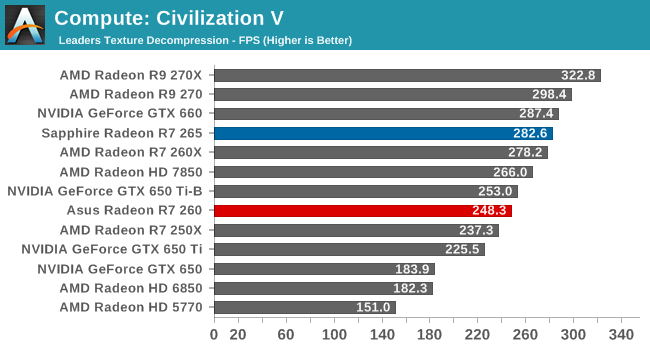
Similar to the 3DMark pixel throughput test on the last page, the Civilization V texture decompression tests highlights the fact that the R7 265 and R7 260X are closer than one would expect in certain edge cases. Once again the R7 260X’s higher clockspeed is helping it keep the gap between it and the R7 265 very narrow, as the two have very similar shader throughput in the end.

The story is much the same with LuxMark as it was Civilization V, with AMD cards once again being sorted almost exactly by shader throughput. Though it’s worth pointing out that NVIDIA’s performance under LuxMark has greatly improved as of the R334 drivers. It’s not enough to close the gap with AMD, but it’s closer than it once was.

Like LuxMark, Sony Vegas is a benchmark dominated by AMD. The lead here is so great that the R7 265 could run this benchmark twice over before the GTX 660 completed it once. Nor would the R7 260 be too far behind in that respect.
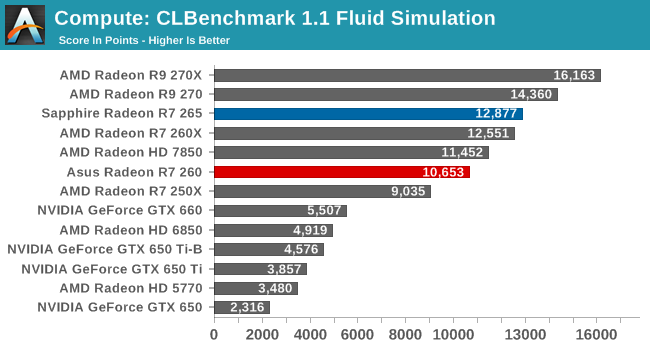

Both CLBenchmark’s fluid simulation benchmark and the computer vision benchmark go to AMD here. The GTX 650 Ti and GTX 660 are not competitive here.
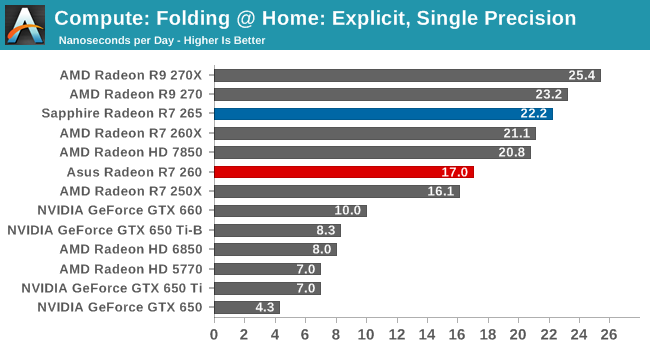
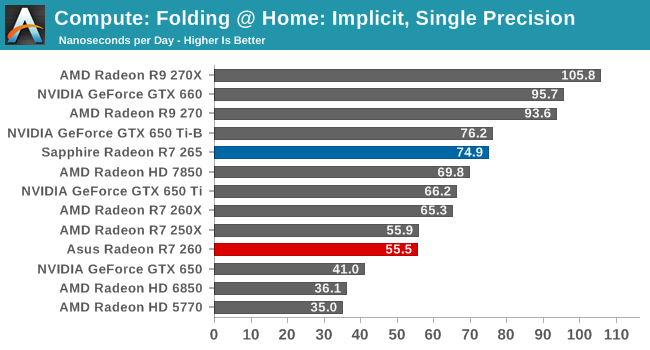
With AMD’s Catalyst 14.1 drivers, AMD has been able to increase their Folding @ Home performance by several percent, closing some gaps while widening others. In the Explicit SP benchmark AMD further increases their lead here, with even the lowly R7 250X holding a significant lead over the GTX 660. On the other hand the R7 265 can’t come close to the GTX 660 under Implicit SP; there’s a lack of raw shader throughput to make it happen.
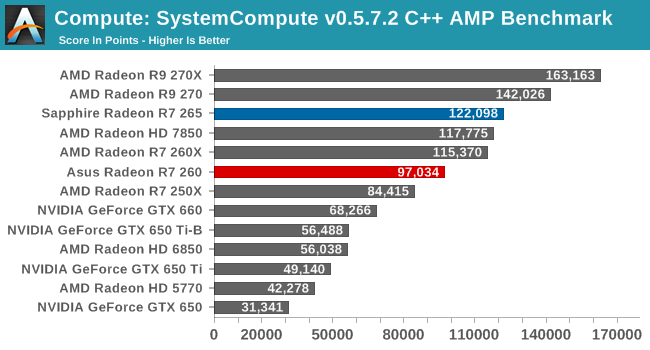
SystemCompute is another compute benchmark that goes to AMD. The R7 265 and R7 260 handily beat the GTX 660, never mind the GTX 650 Ti.










52 Comments
View All Comments
edzieba - Thursday, February 13, 2014 - link
It's not just a tool for flagging up multi-screen/multi-GPU stutter issues. By showing the distribution of frame times, you can tell the difference between two cards that both average 50fps, but where one delivers every frame in 20 +/- 1 ms, and the other at +/- 5. The latter will deliver a much smoother output, which is not apparent from a single-number metric.Anandtech readers are a pretty smart bunch. We'd much prefer Graph Overload to too little information, particularly when other sites provide the additional information as standard.
Death666Angel - Thursday, February 13, 2014 - link
Sounds like the first (+/- 1 ms) would deliver the smoother experience than the latter (+/- 5 ms). :)edzieba - Monday, February 17, 2014 - link
Urp, that's what I /meant/ to write...Cellar Door - Thursday, February 13, 2014 - link
This rebadge game is terrible. Both parties are guilty here but the fact that these products get reviewed on regular basis just makes no sense.Here is a proper review of the of the 265 and 260: Lets confuse everyone with new nomenclature and what basically is a 7850 from close to 2 years ago. These cards are nothing but cash cows for the mainstream.
This card is being launched to draw attention to AMD just before the GTX 750 Ti comes to the market, its nothing but emptying the stocks of poor quality chips.
MrSpadge - Thursday, February 13, 2014 - link
Guess what: they wouldn't build GPUs if they wouldn't expect them to be cash cows!EnzoFX - Thursday, February 13, 2014 - link
THis has always been the case in the not-high-tier cards. Where have you been? I love these cards. What's wrong with an "update" to tried and true cards. I love these single-pcie-power cards. Besides, most games will prob still be targeting this level of power considering it's comparable to the new consoles.Death666Angel - Thursday, February 13, 2014 - link
First time I can remember there being rebadging was with the 8xxx / 9xxx series from nVidia, before that I don't remember it happening.LordOfTheBoired - Friday, February 14, 2014 - link
GeForce4 MX was a modified GeForce2. While not a straight same-component relabel, it WAS intentionally-misleading branding meant to make people think it was an upgrade from the GeForce 3 rather than a downgrade, and was very much in the spirit of the modern rebadge.That's the earliest example that springs to mind here.
rallyhard - Friday, February 14, 2014 - link
I agree that your example, the GeForce4 MX is one of the earliest, and probably one of the most misleading rebrands ever.The first video card I ever purchased was a rebrand that occurred a year earlier, though: the lowly Radeon 7000. It was the exact same card as the previous RV100-based Radeon LE, but they gave it a flashy new name when they introduced the new Radeon 7500 with the RV200 chip.
silverblue - Friday, February 14, 2014 - link
The GeForce 4 MX was probably a worse release than the 2 MX in that the latter was indeed based on the GeForce 2, but lacked the hardware transform and lighting capabilities of the GeForce 2 GTS and the earlier GeForce 256. The GeForce 2 MX 400 was the only model that had a chance of beating the 256 DDR.The Radeon 9000 was a hacked down 8500 LE, but I suppose considering the low number in the 9xxx series, there had to be a low-end part. Besides which, it did still have T&L.
I can't think of any straight rebrands from back then apart from the 7000.